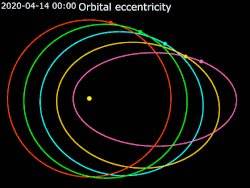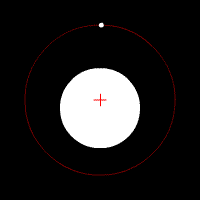
Back مدار إهليلجي Arabic Òrbita el·líptica Catalan Eliptická dráha Czech Órbita elíptica Spanish مدار بیضی Persian Ellipsirata Finnish Orbite elliptique French दीर्घवृत्त कक्षा Hindi Orbit elips ID Orbita ellittica Italian
This article includes a list of references, related reading, or external links, but its sources remain unclear because it lacks inline citations. (January 2021) |

0.0 · 0.2 · 0.4 · 0.6 · 0.8




| Part of a series on |
| Astrodynamics |
|---|
In astrodynamics or celestial mechanics, an elliptic orbit or elliptical orbit is a Kepler orbit with an eccentricity of less than 1; this includes the special case of a circular orbit, with eccentricity equal to 0. In a stricter sense, it is a Kepler orbit with the eccentricity greater than 0 and less than 1 (thus excluding the circular orbit). In a wider sense, it is a Kepler orbit with negative energy. This includes the radial elliptic orbit, with eccentricity equal to 1.
In a gravitational two-body problem with negative energy, both bodies follow similar elliptic orbits with the same orbital period around their common barycenter. Also the relative position of one body with respect to the other follows an elliptic orbit.
Examples of elliptic orbits include Hohmann transfer orbits, Molniya orbits, and tundra orbits.